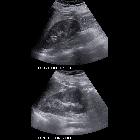dromedary hump


Dromedary humps are prominent focal bulges on the lateral border of the left kidney. They are normal variants of the renal contour, caused by the splenic impression onto the superolateral left kidney.
Dromedary humps are important because they may mimic a renal mass, and as such is considered a renal pseudotumor.
Radiographic features
The feature that establishes normality is that the calyces underlying the hump extend further laterally into the hump than the other calyces . A dromedary hump must have the same radiological features as the adjacent cortex, whatever the modality.
Nuclear medicine
Dimercaptosuccinic acid (Tc-99m DMSA) isotopic examination can also be used to confirm the presence of a dromedary hump and exclude malignancy; the former shows normal uptake whereas the latter does not .
History and etymology
Named after the dromedary camel (see Figure 2), which is a well known member of the camel family that has a single hump.
Siehe auch:

 Assoziationen und Differentialdiagnosen zu Milzbuckel:
Assoziationen und Differentialdiagnosen zu Milzbuckel:
